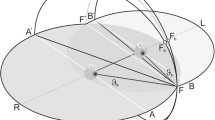Abstract
Eye movements are basically limited to two degrees of freedom, as described by Donders' and Listing's laws. Complex patterns of innervation maintain the geometric constancy of the retinal meridians, presumably via visual feedback acting through orientation-specific neurons in the cortex. Interactions between torsional and vertical movements of the eyes can be demonstrated by stimulating ocular torsion and detecting secondary vertical deviations. Geometric considerations show that significant peripheral disparities occur with convergence and eye movements, dictating large Panum's fusional areas in the periphery. Good visual acuity in man must thus be limited to the fovea, but the large peripheral Panum's fusional areas allow sensory cyclofusion of up to 8°. In addition, motor cyclofusion occurs in the presence of large-field stimuli, further helping to minimize problems from torsional diplopia both in normal individuals and in patients with ocular motor pareses.
Similar content being viewed by others
References
Balliet R, Nakayama K (1978) Training of voluntary torsion. Invest Ophthalmol Vis Sci 17:303–314
Crone RA (1973) Diplopia. Exerpta Medica, Amsterdam, p 55
Crone RA, Everhard-Halm Y (1975) Optically induced eye torsion. I. Fusional cyclovergence. Graefe's Arch Clin Exp Ophthalmol 195:231–239
Duke-Elder S (1958) System of ophthalmology. I. The eye in evolution. Mosby, St Louis, p 660
Guyton DL (1983) Clinical assessment of ocular torsion. Am Orthoptic J 33:7–15
Guyton DL, Noorden GK von (1977) Antagonism between cyclorotations and vertical rotations of the eye. Invest Ophthalmol Vis Sci 16:40–41
Guyton DL, Noorden GR von (1978) Sensory adaptations to cyclodeviations. In: Reinecke RD (ed) Strabismus. Grune & Stratton, New York, pp 399–403
Herzau V, Joos-Kratsch E (1984) Objective and subjective evaluation of cyclovergence and cyclofusion. Doc Ophthalmol 58:85–90
Kertesz AE, Hampton DR (1983) The unreliability of subjective probe estimates of cyclofusional vergence performance. Graefe's Arch Clin Exp Ophthalmol 220:100–101
Kertesz AE, Lee HJ (1986) Sensory interaction among neighboring retinal regions during fusional compensation. Invest Ophthalmol Vis Sci 27:79
Kertesz AE, Sullivan MJ (1978) The effect of stimulus size on human cyclofusional response. Vision Res 18:567–571
Kushner BJ (1985) The role of ocular torsion on the etiology of A and V patterns. J Pediatr Ophthalmol Strabismus 22:171–179
Nakayama K (1977) Geometrical and physiological aspects of depth perception. In: Benton S (ed) Image processing. Proc Soc Photo-Optical Instrumentation Engineers 120:1–9
Nakayama K (1978) A new method of determining the primary position of the eye using Listing's law. Am J Optom Physiol Opt 55:331–336
Nakayama K (1983) Kinematics of normal and stabismic eyes. In: Schor CM, Ciuffreda KJ (eds) Vergence eye movements: basic and clinical aspects. Butterworths, Boston, pp 543–564
Noorden GK von (1984) Clinical and theoretical aspects of cyclotropia. J Pediatr Ophthalmol Strabismus 21:126–132
Robertson K, Schor C (1986) Changes in retinal correspondence induced by disparity vergence. Invest Ophthalmol Vis Sci 27:79
Schor CM (1983) Fixation disparity and vergence adaptation. In: Schor CM, Ciuffreda KJ (eds) Vergence eye movements: basic and clinical aspects. Butterworths, Boston, pp 465–516
Schor CM, Tyler CW (1981) Spatio-temporal properties of Panum's fusional area. Vision Res 21:683–692
Schor C, Wesson M, Robertson KM (1986) Combined effects of spatial frequency and retinal eccentricity upon fixation disparity. Am J Optom Physiol Opt 63:619–626
Tyler CW (1983) Sensory processing of binocular disparity. In: Schor CM, Ciuffreda KV (eds) Vergence eye movements: basic and clinical aspects. Butterworths, Boston, pp 199–296
Walls GL (1942) The vertebrate eye and its adaptive radiation. Cranbrook Press, Bloomfield Hills, Mich, pp 295, 306, 312
Westheimer G (1973) Saccadic eye movements. In: Zikmund V (ed) The oculomotor system and brain functions. Publishing House of the Slovak Academy of Science, Bratislava, p 62
Westheimer G, Blair SM (1972) Mapping the visual sensory onto the visual motor system. Invest Ophthalmol 11:490–496
Author information
Authors and Affiliations
Additional information
Dedicated to Dr. G.K. von Noorden on the occasion of his 60th birthday
Republished with permission from the American Orthoptic Journal (1987) 37:13–21
Rights and permissions
About this article
Cite this article
Guyton, D.L. Ocular torsion: Sensorimotor principles. Graefe's Arch Clin Exp Ophthalmol 226, 241–245 (1988). https://doi.org/10.1007/BF02181189
Issue Date:
DOI: https://doi.org/10.1007/BF02181189




